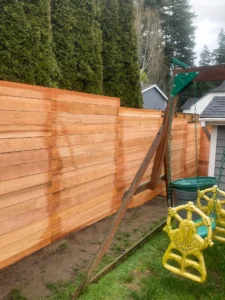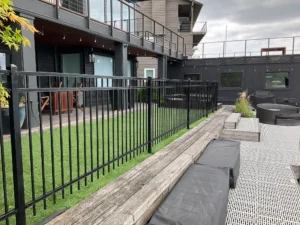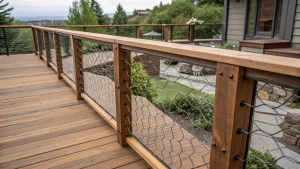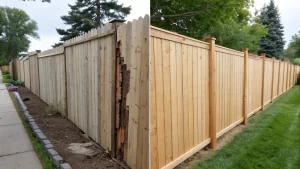Inline Fence's complete guide to selecting the perfect height, style, and materials for your Washington horizontal fence installation
Horizontal fences are quickly becoming a favorite among Washington State homeowners, thanks to their sleek, modern horizontal fence look that adds both charm and structure to outdoor spaces. But when it comes to designing one, height plays a surprisingly big role — affecting everything from neighborhood compliance to backyard privacy. If you’re considering horizontal fence installations in Washington State, understanding height regulations is your first step.
Your fence’s height can determine not just how much privacy you enjoy, but also how balanced and cohesive your property appears. This guide explores the key aspects of horizontal fence design — from local height limits and permit rules to creative design strategies and material choices. You’ll also learn how to plan your privacy horizontal fence to meet both Washington’s regulations and your aesthetic goals, ensuring a cohesive appearance with the rest of your yard and home.
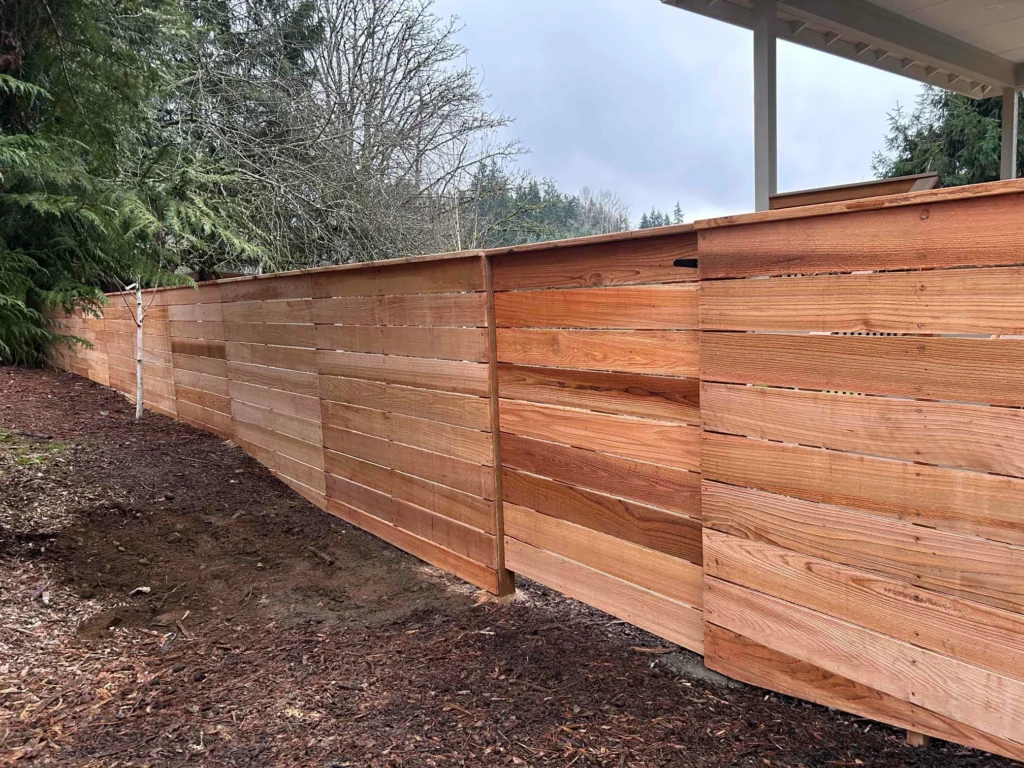
Understanding Washington State horizontal fence height regulations
Before diving into materials and style options, it’s essential to understand the height rules that guide every fencing project in Washington State. Local regulations set clear limits on how tall your fence can be, and knowing these ahead of time helps you design confidently while staying compliant with neighborhood standards.
Standard height limits for residential properties
Most Washington cities follow similar guidelines for residential fencing. Typically, you can install a 4 foot horizontal fence in your front yard and up to six feet in your backyard or along the sides of your property. These restrictions are designed to maintain visibility for drivers and pedestrians while preserving the visual harmony of neighborhoods.
When planning a front yard horizontal fence, remember that these limits apply whether you’re using traditional vertical fences or horizontal designs. According to SDCI guidelines, residential zones generally cap fences at six feet, with allowances for an extra two feet of decorative elements such as lattice or trellises.1 This gives homeowners a little creative flexibility while maintaining safety and sightline standards for local streets.
Homeowners who want extra privacy or decorative detail should always verify local codes or HOA rules before construction to avoid the need for later adjustments.
When you need permits and special considerations
In most cases, fences up to six feet high don’t require a formal permit, but there are exceptions worth noting. Corner lots, sloped yards, and properties adjacent to public spaces may have additional requirements that affect your final design. If you plan a fence taller than six feet or within certain setback zones, a permit or variance could be necessary.
During the review process, local inspectors may examine structural details like horizontal fence spacing and horizontal fence boards to ensure the fence maintains both stability and a consistent appearance. HOAs can also have their own restrictions on materials, spacing, or board orientation, especially in planned communities where uniform aesthetics are part of the design standard.
Not sure if your project requires permits? Contact us for a free consultation to review your specific situation.
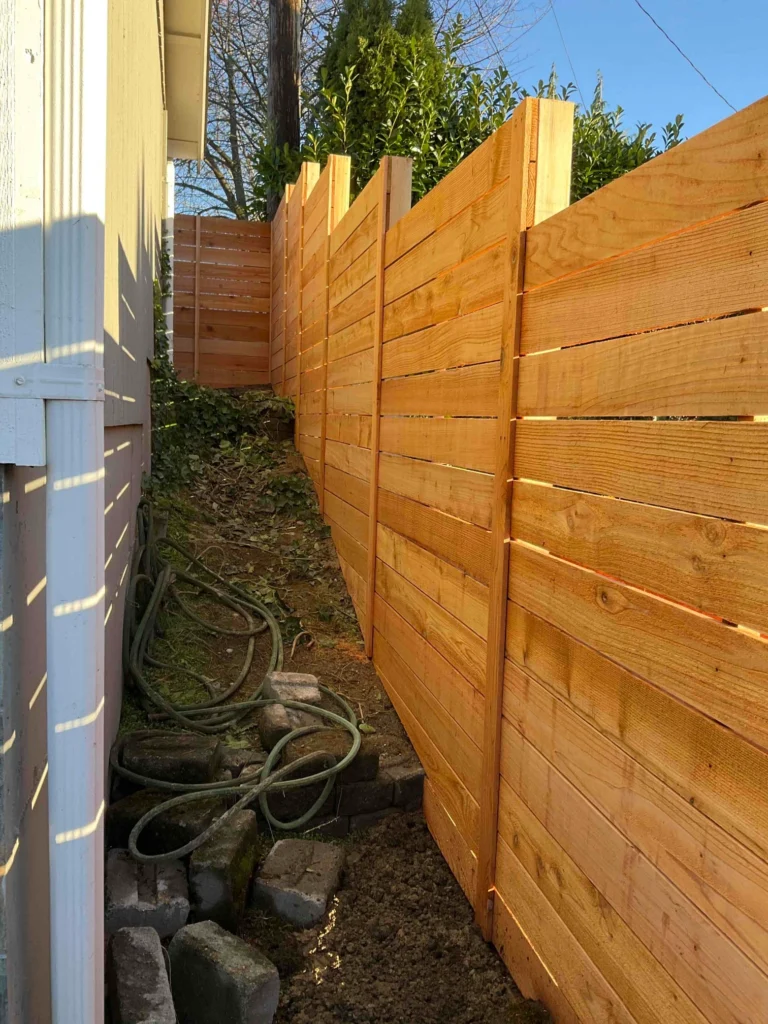
Privacy considerations for different horizontal fence heights
Once you understand the rules, the next step is deciding how tall your fence should be for the privacy you want. In Washington State, where neighborhoods often mix open views with close-set homes, your fence’s height will shape both how private and how open your outdoor space feels.
4-foot fences: partial privacy with openness
A 4 foot horizontal fence — sometimes written as a 4′ horizontal fence — offers moderate privacy while maintaining a friendly, open look. These shorter fences are ideal for front yards or decorative boundaries, defining the fence line without creating a sense of enclosure. They help establish curb appeal, mark garden spaces, and complement landscaping features. While they don’t fully block visibility, their balance between form and function makes them a popular choice for homeowners who want light, air, and community connection without complete seclusion.
6-foot fences: optimal privacy for backyards
For homeowners seeking a privacy horizontal fence that truly shields their outdoor areas, the six-foot option remains the most common and effective choice. A horizontal fence at this height provides excellent coverage from nearby windows or streets, turning backyards into comfortable, secluded retreats. The design naturally blocks sightlines while maintaining a clean, contemporary look that suits both modern homes and traditional properties. Six-foot fences also offer noise reduction and wind protection — ideal for urban neighborhoods or properties with active surroundings.
Short horizontal fences: decorative versus functional
A short horizontal fence — typically three to four feet tall — leans more decorative than private. These are perfect for accenting front landscapes, garden paths, or courtyard entrances. While they don’t provide full coverage, their visual appeal and horizontal orientation create a sense of width and modern character. Homeowners often use these designs to complement architectural features or highlight plantings, emphasizing style and definition rather than seclusion.
⭐⭐⭐⭐⭐
“I am beyond happy with the results; the new fences are beautiful and very sturdy, and the cherry on top is that while we were told it would be a 3-day project, the crew finished in just 2 days! We will absolutely be coming back to Inline Fence for any and all of our future fencing needs, and will gladly recommend them to anyone we know who is looking for fencing solutions in the area.”– Zak P.
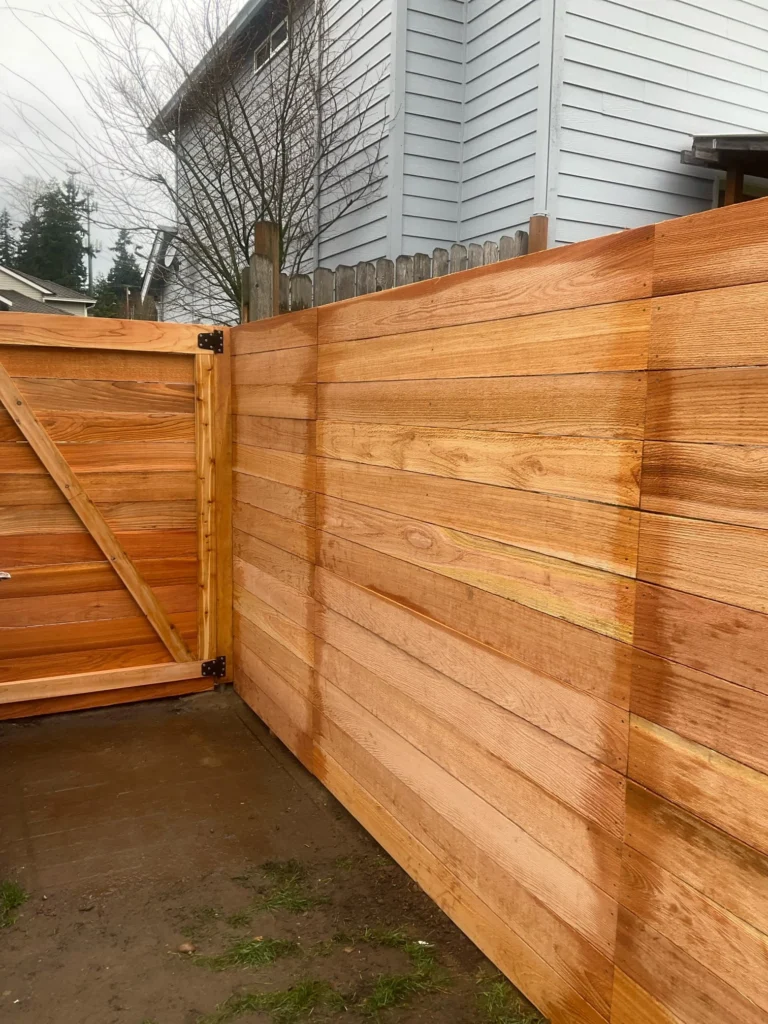
Horizontal fence ideas for different style preferences
Height limits might seem restrictive at first, but they don’t have to limit your creativity. Washington homeowners are finding countless ways to personalize their fences with materials, spacing, and finishes that reflect their home’s architectural styles. Whether you prefer a warm natural look or a sleek modern design, there’s a stylish solution that meets regulations while elevating curb appeal.
Modern and contemporary horizontal wood fence designs
A horizontal wood fence instantly conveys a modern, minimalist feel — its clean lines naturally emphasize width and structure. Many Washington homeowners favor horizontal wood planks for a crisp, architectural finish that pairs well with mid-century or modern homes. The contemporary horizontal fence style often features evenly spaced boards, matte finishes, and metal accents for striking contrast.
Designs like these can be customized for different heights without losing balance or visual flow. For inspiration on horizontal fence modern aesthetics that work across various neighborhoods, browse our completed projects featuring homes across Washington State. These fences integrate horizontal wooden boards seamlessly with existing wood decks, creating a cohesive appearance.
Horizontal cedar fence and other material choices
Cedar remains the gold standard for Washington homeowners — durable, naturally rot-resistant, and beautiful in every season. A horizontal cedar fence not only weathers gracefully, but also withstands the region’s moisture-rich climate better than many alternatives. However, your horizontal fence material can vary depending on budget and maintenance goals.
Redwood and pressure-treated lumber are solid options, while composite panels offer low-maintenance appeal with modern finishes. Choosing the best wood for horizontal fence projects depends on the level of privacy, budget, and preferred appearance. Even the horizontal boards themselves can be customized by width, spacing, or stain tone to achieve different visual effects. We offer custom add-ons and finishing options to personalize your horizontal fence design.
Board fence spacing and its impact on style and privacy
Spacing is the secret design element that makes a board fence stand out. Tight horizontal fence spacing enhances privacy and creates a sleek, uniform appearance. Wider horizontal fence spacing introduces light and airflow, giving your yard a more open and airy feel. Striking the right balance ensures your fence looks intentional — not just functional — while complementing your home’s architecture and surroundings.
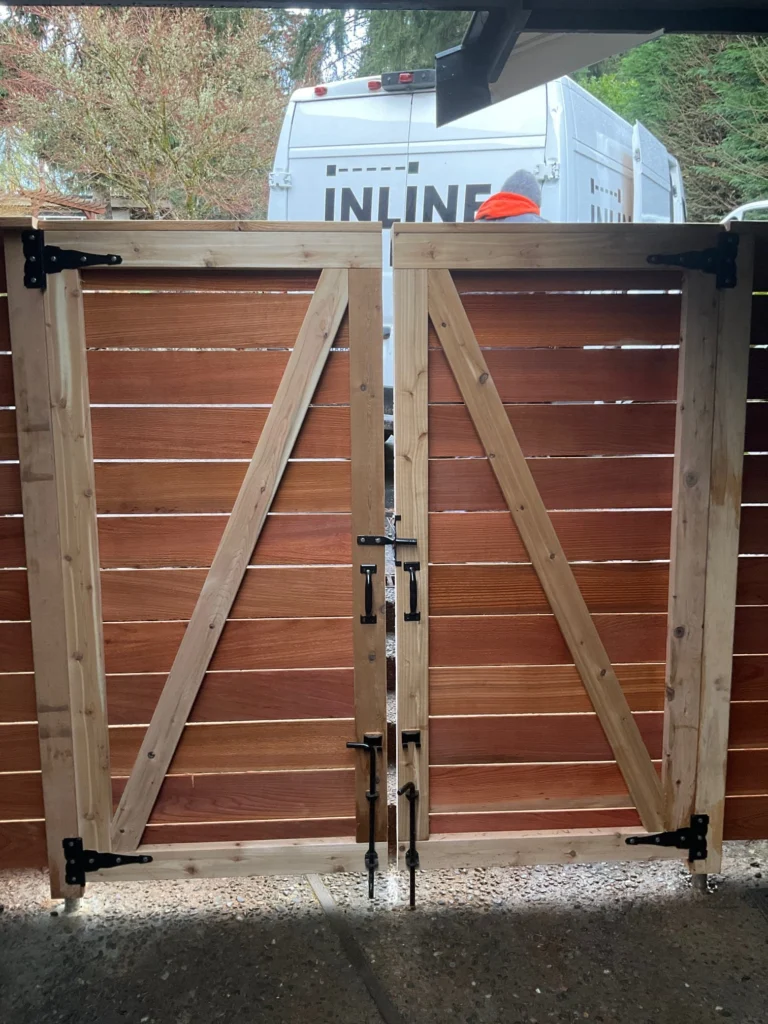
Front yard horizontal privacy fence: balancing regulations and design
Front yards often face the toughest restrictions, but that doesn’t mean you can’t achieve privacy or style. Washington’s residential codes typically limit fence height in front yards to four feet, encouraging openness and visibility for safety. Still, with a little creativity, homeowners can design front-facing fences that look intentional, modern, and compliant with local laws.
Front yard fence ideas that comply with height rules
Working within a four-foot height limit doesn’t have to mean compromising on design. There are plenty of front yard approaches that blend beauty and functionality. Layering textures, adjusting board width, or alternating solid and slatted sections can all add visual depth while maintaining an open feel.
Incorporating landscaping elements — like shrubs or planters — can also enhance privacy without technically exceeding the height cap. Creative horizontal fence ideas such as staggered boards or framed panels can transform a short fence into an eye-catching architectural feature.
For real-world inspiration, this custom height horizontal cedar fence installation in Seattle demonstrates how homeowners can achieve both compliance and curb appeal. The project highlights how local craftsmanship and thoughtful layout can make even low fences feel substantial. Whether you’re adding greenery or experimenting with finishes, these fence ideas show that style and structure can coexist beautifully within front yard limits.
Creating horizontal privacy using fence posts despite height restrictions
Achieving privacy in the front yard requires strategy. A horizontal privacy fence can still deliver coverage when paired with smart design choices. Tighter spacing between boards, layered greenery, or decorative screening near entry points can subtly enhance privacy without breaking regulations.
Even the placement of fence posts plays a role — by aligning them creatively, you can add visual rhythm and create subtle depth. Our team often recommends combining design and landscaping to create layered horizontal privacy that feels natural, not obstructive. See how this horizontal cedar and hogwire combination fence maximized privacy within front yard restrictions. Working with a Seattle fence company ensures your design meets neighborhood-specific regulations while achieving your preferred balance of openness and seclusion.
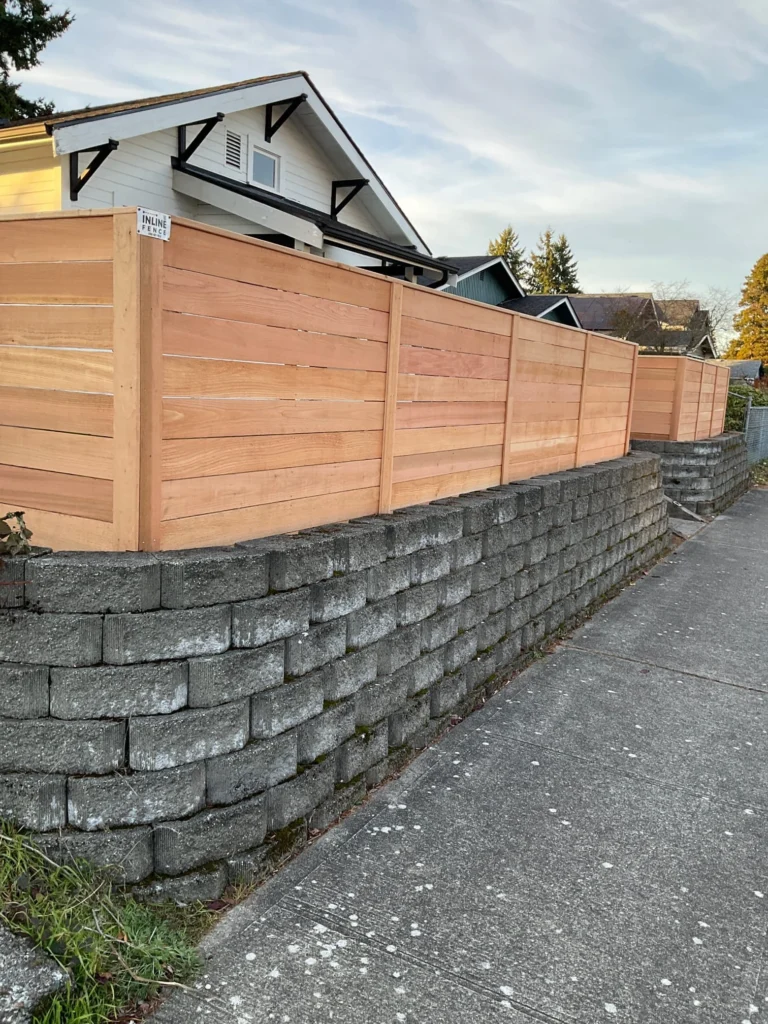
Practical installation considerations for horizontal fences
Building a horizontal fence in Washington State is more than picking the right wood and style — it’s about navigating terrain, ensuring stability, and meeting regulations. From sloped yards to maximum height limits, understanding installation considerations will help you achieve a durable, attractive fence that performs well year-round.
Special challenges with slopes and uneven terrain
Installing a horizontal fence on a slope requires careful planning. Unlike flat yards, sloped properties demand attention to both aesthetics and stability. There are two common approaches: stepping the fence, where each section is level and follows the slope in steps, or racking, where the boards follow the slope continuously. Both methods maintain visual consistency but affect how you measure height and place post holes.
Washington’s varied terrain means slopes are common, especially in hilly neighborhoods. Our experienced Kent fence installers specialize in slope installations throughout King County, ensuring that your fence remains straight, secure, and compliant with local regulations. Proper post placement and foundation support are critical to prevent leaning, warping, or movement over time.
Construction tips for stability at maximum heights
When building taller horizontal fences, structural integrity is key. Correct horizontal fence boards attachment, consistent spacing of horizontal boards, and sturdy posts all contribute to a long-lasting installation. Posts should be set deep enough in concrete to resist Washington’s wind and rain, and boards should be secured with corrosion-resistant fasteners to prevent warping.
Following ICC construction guidelines, fences exceeding seven feet often require engineering approval to ensure stability.2 Additionally, all our installations include comprehensive warranty coverage for peace of mind, so you can enjoy your fence knowing it’s built to last through years of Pacific Northwest weather. While installation may be time consuming, careful planning minimizes labor costs and ensures a minimal maintenance outcome.
Making the right choice: from horizontal boards to final design
Choosing the right horizontal fence involves balancing privacy, style, and compliance with Washington’s height regulations. Drawing from Inline Fence’s expertise in Washington State, we recommend starting by identifying your primary goal — whether it’s seclusion, aesthetic appeal, or a mix of both.
Consider the context of your property — yard size, slope, neighboring homes, and natural light — when selecting horizontal boards and materials. Cedar and other premium woods offer durability and classic appeal, while composite options may provide low-maintenance solutions. Reviewing horizontal fence ideas and understanding what wood to use for horizontal fence projects ensures you choose a solution that meets both your functional and visual needs.
Once your materials and design are selected, make sure your plan adheres to local regulations and neighborhood expectations. Ready to move forward? Explore our horizontal fence services and find the perfect solution for your property.
Finally, to bring your project to life, request a free quote and let’s design a horizontal fence that perfectly balances height regulations, privacy, and style for your Washington home. With thoughtful planning, the right materials, and professional guidance, your horizontal fence will deliver long-lasting beauty and functionality.


